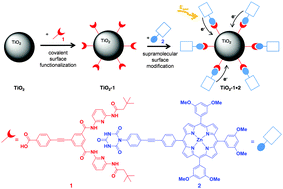Hydrogen bonding mediated orthogonal and reversible self-assembly of porphyrin sensitizers onto TiO2 nanoparticles†
Abstract
We report on the orthogonal, highly directional and reversible self-assembly of porphyrins onto TiO2 nanoparticles by means of hydrogen bonding interactions. Unifying the stable covalent surface attachment of tailored, synthesized Hamilton receptors with the advantages of a non-covalent supramolecular immobilization of porphyrin cyanurates resulted in a redox- and photo-active nanohybrid. The latter was successfully implemented into a new type of supramolecular dye-sensitized solar cells.

- This article is part of the themed collection: Commemorating Michael Faraday (1791-1867)

 Please wait while we load your content...
Please wait while we load your content...